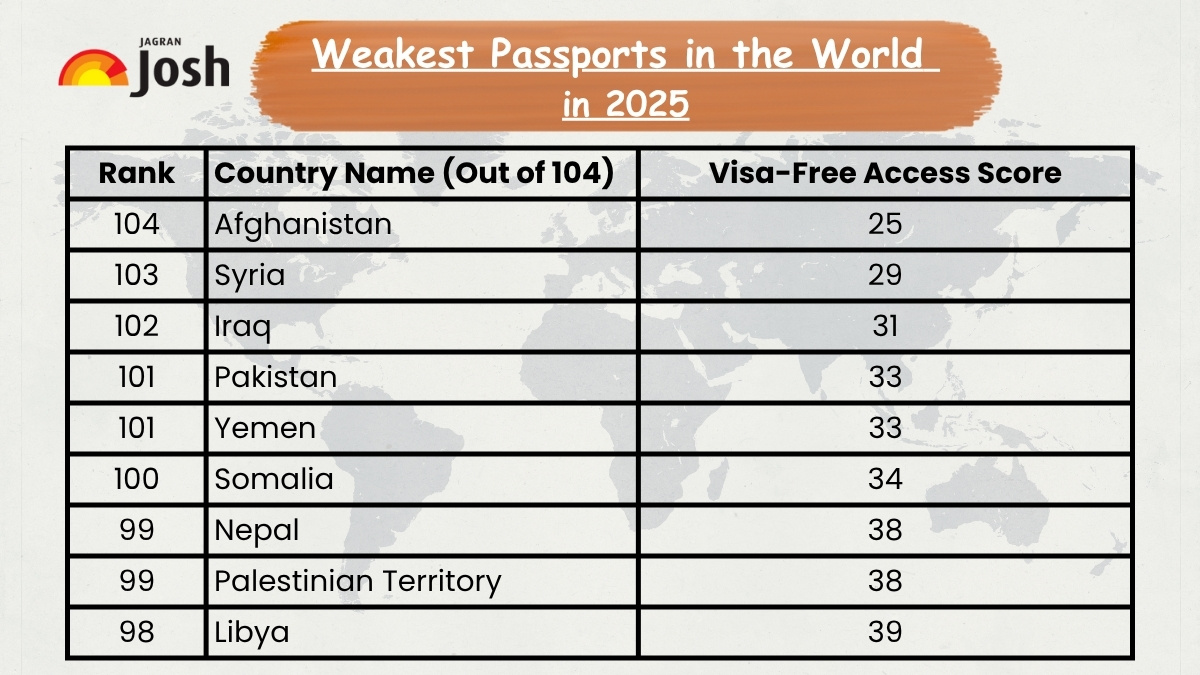Weakest passports in the World: The number of passports a country has is more than just a number; it tells you how well it gets along with other countries, how stable its economy is, and where it stands in the world. The Henley Passport Index, which gets its information from the International Air Transport Association (IATA), just came out with its most recent list of the best passports for 2025. It counts how many places a person with a passport can go without a visa ahead of time. This includes places where they can go without a visa, get a visa when they get there, or get an electronic travel authority.
Singapore's passport is currently the strongest in the world, allowing visa-free entry to 193 countries. However, the story at the bottom of the list is a stark reminder of how different the world is. The weakest passports in the world belong to countries that are in long-term conflict, have unstable governments, or are in humanitarian crises. This makes it very hard for their people to travel, look for work, or even visit family in other countries. To understand how global mobility will work in 2025, you need to know what the weakest passport is and why.
List of 9 Weakest Passports in the World in 2025
The table below shows the 9 weakest passports in the world, ranked from weakest to strongest based on the most recent Henley Passport Index (July 2025 Update).

| Global Rank (Out of 104) | Country | Visa-Free Access Score |
| 104 | Afghanistan | 25 |
| 103 | Syria | 29 |
| 102 | Iraq | 31 |
| 101 | Pakistan | 33 |
| 101 | Yemen | 33 |
| 100 | Somalia | 34 |
| 99 | Nepal | 38 |
| 99 | Palestinian Territory | 38 |
| 98 | Libya | 39 |
What Makes a Passport Powerful?
A passport's strength, or global mobility score, is determined by more than just the number of visa-free destinations. It has a lot to do with how well a country does in the world.
1. Strong Diplomatic Relations
Visa-free agreements are essentially symbols of mutual trust and strong diplomatic partnerships between nations. Countries that actively negotiate bilateral trade and travel pacts, like the UAE, often see rapid passport improvements.
2. Economic Stability
Nations with a higher GDP per capita are often viewed as lower risk for unauthorized migration or visa overstays. Other countries are more likely to let people from stable economies cross their borders because they expect to make more money from tourism and investment.
3. Political Stability and Security
A country that is not in a civil war, has no internal conflict, or is not a high security threat is seen as a good partner. Countries with a lot of political instability, on the other hand, have their passports checked and questioned very closely.
Also Read - What is the Difference Between B1 and B2 Visa for the US? (Explained)
Which is the Most Powerful Passport in 2025?
According to the latest Henley Passport Index ranking for 2025, Asian nations continue to dominate the top of the global mobility spectrum.
| Rank | Country | Visa-Free Access Destinations |
| 1 | Singapore | 193 |
| 2 | South Korea | 190 |
| 3 | Japan | 189 |
The divide in the latest passport index ranking for 2025 clearly illustrates the global mobility chasm, with a staggering difference of nearly 168 destinations between the top-ranked and the very bottom. For citizens of these nine countries, their passports are a daily barrier, proving that geopolitical and internal stability are the true keys to universal travel freedom.
Comments
All Comments (0)
Join the conversation